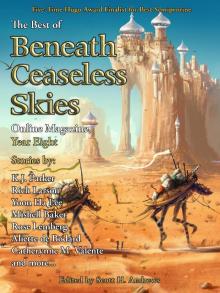


The Atlas of Middle-earth
Karen Wynn Fonstad
ERIADOR Cross Section: WEST-EAST (OFFSET WEST)
WILDERLAND
Wilderland
WILDERLAND WAS SHOWN ON TOLKIEN’S MAP as synonymous with Rhovanion;1 yet a broader definition would include all of the lands east of the Ford of Bruinen and north of Lórien—the area known as “The Wild.”2 Less has been said about this region because, perhaps, there was less to be said, and because fewer clues were given. Only three things were evident: (1) Soluble limestone probably was present at Thranduil’s dwellings; (2) continental glaciation had occurred; and (3) crystalline rock formed the core of at least some of the hills.
The path across Mirkwood taken by Thorin and Company was apparently fairly level but had just enough ups and downs to prevent Bilbo from even noticing that he was at the bottom of a wide valley when he climbed the great oak.3 This bowl-like valley might have been a hollow—that is, a valley in which the water seeps into the limestone and flows out in underground rivers. It was close enough to King Thranduil’s to be in a soluble limestone bedrock. Thranduil’s underground palace, complete with columns of “living stone” and “underground river,4 were probably limestone solution caverns, reportedly enhanced with the assistance of Dwarves.5
The extensive bogs and marshes at the end of both forest roads, the Long Marshes along the Forest River, the “tumbled land” between Lonely Mountain and its nearest neighbors to the northeast,6 and most especially the description of Long Lake, all point toward effects of continental glaciation. The “shingles” piled at the feet of the promontory near Lake-town7 could easily have resulted from glacial till—a conglomeration of rocks ranging from gravels to boulders, which the glacier had captured and carried along. Most importantly, Long Lake “filled what must once have been a great deep rocky valley.”8 It is reminiscent of the finger lakes of New York. South of Long Lake the ruggedness was absent, for, between the eaves of Mirkwood and the River Running, Rhovanion had occupied “wide plains.”9
The Grey Mountains, Iron Hills, and the Lonely Mountain all were richly mineralized. Erebor harbored both gold and jewels, the most fabulous being the Arkenstone.10 The major yield of the Iron Hills is self-evident. No specific references were made to the products of the Grey Mountains, only that they were rich.11
The Grey Mountains may originally have been part of the extensive Iron Mountains. This assumption was based on three clues: (1) Once the location of Thangorodrim was set, the approximate position of the Iron Mountains aligned perfectly with this later range.12 The great parent chain might have been only partially destroyed by the Valar, leaving remnants scattered across Middle-earth. (2) North of the Ered Engrin lay the “Regions of Everlasting Cold.”13 North of the Ered Mithrin was the “Northern Waste.”14 These may have been synonymous. (3) Dragons bred in the Withered Heaths even before the coming of Thorin I in the Third Age.15 Ores long held the area around Mt. Gundabad.16 Both of these were creatures of Morgoth, and with the breaking of Thangorodrim, the most likely relocation for them would have been in any remaining portions of the Iron Mountains.
All things considered, Wilderland had much potential but was historically plagued by evil Men and creatures—Easterlings, Ores, Trolls, dragons, wolves. In spite of long years of settlement it still remained “The Wild.”
The Misty Mountains
THE TOWERING MOUNTAINS OF MIST were undoubtedly one of the most important features in Middle-earth. It is quite likely that they, as well as the White Mountains, were inspired by the European Alps, in which Tolkien had hiked in 1911.1 The Hithaeglir, raised by Melkor early in the First Age as a hindrance to the riding of Oromë, were a barrier to early westward migrations2 and to the quests of both Bilbo and Frodo. The north-south orientation of some 900 miles would also have blocked the predominating moist winds from the west. The orographic lifting, possibly to as high as 12,000 feet,3 would have produced the cloudy conditions that not only gave the range its name, but that were more locally important in naming Fanuidhol (Cloudyhead), and especially in producing the tremendous thunder-battle from which Thorin and Company sought shelter.4
Landscape Morphology
Few clues were given by Tolkien to allow any analysis of the forces involved in producing the Misty Mountains. If they were comparable to the Alps, they would have been formed by a complex mixture of faulting, folding, doming, and volcanic activity.5 This ruggedness extended into the area west of the mountains, producing tortuous lands all the way from the Ettenmoors in the North,6 through the extremely dissected plateau around Rivendell with its many gullies, ravines, and deep valleys,7 the tumbled hill lands traversed by the Nine Walkers in Eregion,8 and down to the hilly wastelands of Dunland.9 East of the range the Anduin followed a relatively straight course amidst a broad green valley until it reached the wolds south of Lórien.
The one process clearly in action at some time was alpine glaciation. Two of Tolkien’s key terms were features left behind by abrading ice: horn, the sharp-pointed peak cut by ice on three or more sides; and trough, a valley eroded by a glacier until it is U-shaped—broad, with steep walls. Some other landforms described by Tolkien also appeared glacial in origin. For example, an advancing glacier may form rock steps, while a retreating one may leave recessional moraines. Either process could dam lakes or tarns that might empty over the dam in falls or rapids.10 Many of these features were found in the region of Moria: Caradhras meant the Redhorn;11 after defeating the Balrog, Gandalf lay atop Silvertine on the “hard horn”;12 just past the point where the Nine Walkers turned back from the Redhorn Pass, the path ran “in a wide shallow trough”;13 and the Silverlode went “leaping down to the trough of the valley.”14 Rapids bubbled down the Dimrill Stair into the Mirrormere. The Mirrormere itself was a classic example of a moraine-dammed lake—“long and oval thrusting into the upper dell.” The Silverlode did not, however, empty directly from the lake but filtered through the loose till of the moraine and appeared from an icy spring about a mile below. Together with a tributary it plunged over a fall downstream at what may have been still another moraine.15 The valley at the west gate of Moria was possibly also glacially carved, for it was relatively flat, with towering walls, and the lake dammed by the otherworldly agent was typically long and narrow.16
Because alpine glaciation appeared in the central part of the mountains, it had probably occurred in the higher elevations throughout the range—especially in the colder north. Tolkien’s drawing of the Goblins’ gate as viewed from the eagles’ eyrie17 and his description of the peaks as “spikes of rocks”18 reinforced the impression of jagged mountaintops. Even in the south, tall Methedras was snowcapped.19
Rock Type
Mountain ranges usually have as complex a mixture of rock types as they have mountain-forming processes. In the Misty Mountains only three types of clues could aid in discerning the bedrock: color, minerals, and landforms.
Most of the colors mentioned were not pertinent to the main range but to the hill lands to its west. Red stone was mentioned near both Rivendell and Moria. In the Trollshaws the East Road cut through “moist walls of red stone”20 on its last leg, descending to the Ford of Bruinen, where the Black Riders attacked. In the western part of the Trollshaws Thorin and Company crossed a “rushing red” river, indicative that it was carrying sediment from the red soil (although if this were the Mitheithel [“grey-spring”], red may not have been its usual color).21 Near Moria the Fellowship scrambled through a barren country of “red stones” north of the Sirannon, which also had “brown and red-stained stones [on] its bed.”22 The rock west of Moria may have been the same as that west of Rivendell. It could have been either sandstone or quartzite, for both of those can be red.
In the mountain range itself, only Caradhras was noted as the “Redhorn,” while the other mountain rock was described as gray.23 It seems unlikely that Caradhras, the tallest of the Mountains of Moria, would have been composed of the same red rock found in the foothills—especially as the other peaks were obviously of different material. One of two
things may have accounted for its color: Its bedrock was a third rock type not present in either the foothills or the surrounding mountains, or its bedrock was not red at all but merely reflected rays of the rising sun.24
THE MISTY MOUNTAINS
One additional factor may shed light on the subject—mineralization. The lodes of mithril, an ore found nowhere else, were “north towards Caradhras, and down to darkness.”25 Veins of precious ores normally result from repeated igneous intrusions into faults.26 If intrusions had occurred, extrusions might have also been present; and the Redhorn might have been an isolated peak of igneous rock, such as andesite porphyry, which is dull pink or red.27
The other mountains in the area were, as mentioned, gray at the surface. So many rock types are gray that it would be futile to attempt any discussion without further information. The rock at the core, however, was probably crystalline. Moria was a highly mineralized area, with lode veins of silver, gold, and iron. The jewels of Moria, “beryl, pearl, and opal pale,”28 were such an unlikely mixture that some may not have been mined there at all. Instead, they were perhaps received in trade—especially the pearls, which are usually “mined” from fresh- or saltwater animals, not rock, unless of course they referred to cave pearls, which sometimes can form in gypsum cavern systems.29 Perhaps a better explanation is that Tolkien originally listed rubies instead—a gem that would have been far more likely to occur with the others.30
It is difficult to determine if any of the formations elsewhere in the mountains were the same as those at Moria. Similar processes may have been involved in the south, for not only was Isengard volcanic,31 but the ore for the copper and iron pillars was probably mined in that vicinity.32
In the northern part of the range where Thorin and Company “toured” the Goblin-tunnels, a very different process was present—cavern formation. Gollum’s cave, complete with its slimy island and subterranean lake that emptied into a dark stream,33 would probably have been in soluble limestone. Blocks of a more resistant limestone may have constituted the “wide steep slope of fallen stones” that the Dwarves disturbed in their flight from the Goblins.34 The same rock may have formed the “wide shelf” on the outlying mountain where the eagles made their eyries.35 As illustrated by Tolkien, the peak appeared to be capped by layers of limestone.36
Rivers and Roads
In one respect this revised map differs from both the prior Atlas and The Lord of the Rings map: the course of the River Bruinen and the route of the Great East Road between Weathertop and the Ford of Bruinen. As more material became available in print, Tolkien eventually decided, “‘. . . where this is possible and does not damage the story, to take the maps as “correct” and adjust the narrative.’”37 This was apparently part of the decision-making process in the Second Edition of The Lord of the Rings. The First Edition “shows the Road running along the Loudwater ‘for many leagues to the Ford’” while in the Second Edition, this was changed to read “’along the edge of the hills.’”38 The river course shown here is a compromise based on the more detailed analysis in The History.
Tolkien’s original maps showed much wider curves of the Great East Road, but when redrafted for publication by Christopher Tolkien, the latter in retrospect realized that he had flattened the curves of the road:
In 1943 I made an elaborate map . . . the course of the Road from Weathertop to the Ford is shown exactly as on my father’s maps, with the great northward and southward swings. On the map that I made in 1954 . . . however, the Road has only a feeble northward curve between Weathertop and the Hoarwell Bridge, and then runs in a straight line to the Ford.39
Here, as with the River Bruinen, the map has been revised to reflect Tolkien’s original intent, as clarified on two sketch maps from The History.40
The Brown Lands, the Wold, The Downs, and the Emyn Muil
TOLKIEN MAPPED AND REMAPPED this area repeatedly, changing far more than just names. Four distinct designs showed the evolution of the hill lands through which the Anduin flowed. In the first map Nen Hithoel was 120 miles north, lying just south of the Green Hills, which ran east—west in much the same location as shown for the Wold and the Brown Lands. The Border Hills further south lay roughly in the location of the Eastern Emyn Muil.1 As Nen Hithoel shifted south, three additional maps displayed the development of the Emyn Muil (then called the Sarn Gebir, although that term eventually applied only to the rapids.)2 The hills were first shown as a simple east-west ridge, then gradually became a complexly curved series of ridges centering on the lake.3 While the maps did not show as clearly the formations of the Wold area, the illustrations here are carefully designed to fit both story and Primary World features and processes.
All of these areas were related in rock type and morphology. They have been interpreted as layers of sediment gently folded along a southwest-northeast axis. The result was a broad upfold or anticline that narrowed to the northeast. This was complemented by a downfold or syncline that narrowed to the southwest. The Brown Lands, the Wold, and the Downs were all upfolded; the Emyn Muil, downfolded. At the eastern edge of the fold the strata not only bent but broke, forming the cliffwall which Sam and Frodo had such difficulty descending.
The Brown Lands, the Wold, and the Downs
Wold is a Middle English term comparable to the west Saxon weald, a forested area.4 In southeastern England there is a domed region of hills called “The Weald.” Tolkien’s Wold structurally was very similar, although unforested. It, too, was an upfolded ridge or anticline, from which sedimentary layers, with varying degrees of resistance, eroded back to form concentric rings of hills—the Downs.
Downlands occurred both north and south of the Wold. The company floated past the north downs after passing the Limlight. Several days later the great race toward Isengard took much of the company along the western edge of the south downs. Ten miles west lay the Entwash.5 The hills were drier than the valley bottoms, so the Ores held close to them for more solid footing.
These hills were low because the strata were relatively thin. They sloped away gently from the center of the Wold but had a much steeper drop facing inward—“green slopes rising to bare ridges.”6 The sediments may have been chalk, a type of limestone. The Downs of England are chalk and are so permeable that they “are notoriously short of water and are used as grazing lands for sheep.”7 The downs north of the Wold were “rolling downs of withered grass,”8 and those to the south were “long treeless slopes”9 at whose feet “the ground was dry and turf short. . . .”10
The Wold was described as bleak and treeless, and higher than the Downs. The Wold and the Brown Lands were actually parts of the same feature, merely bisected by the Anduin. The resistant rock was highly dissected. The Wold might have been suited to some cultivation just as the Brown Lands had once flourished under the care of the Entwives before the Enemy “blasted all that region.”11
As in the Weald of England, a valley probably lay between the Wold and the in-facing escarpments of the Downs—both north and south. The intersections of these valleys with the west bends of the Anduin created the North and South Undeeps that were utilized by both the Balchoth and the Éothéod for easier river-crossing at the Battle of Celebrant.12
The Emyn Muil
Just as the varying thickness and degree of resistance played a role in the formation of the Wold and the Downs, they continued to do so in the Emyn Muil. These strata were much thicker than those of the Downs. Three main layers of downfolded sediment composed the rocky land. These were most clearly apparent in the western Emyn Muil, where “the Highlands . . . ran from North to South in two long tumbled ridges.”13 The three layers appeared as: (1) the inner eastern ridge, which was the highest, and therefore thickest, layer; (2) the outer western ridge, which was about 120 feet thick, for it stood “twenty fathoms”14 above the third layer; (3) the “wide and rugged shelf which ended suddenly in the brink of a sheer cliff: the East Wall of Rohan.”15
The inner layer of strata had been eroded bac
k from all directions, leaving only a bowl-shaped remnant, known as a synclinal valley. It had relatively long inward slopes and steep outfacing cliffs. The rapids of Sarn Gebir churned through the northern cliffwall of this layer. The rock closest to the river at this location was highly eroded, leaving “chimneys.” The limestone must have been chemically dissolved in some parts, for there were some features of karst topography, such as that found in the Mammoth Cave (Kentucky) area of the United States and the Dalmatian region of Yugoslavia. Where rock below the surface had been dissolved and the overlying strata collapsed, varying sizes of sinkholes occurred. So as the Fellowship toiled in the mile between the river and the portage-way, they came upon many “hidden holes” and “sheer dales.”16














